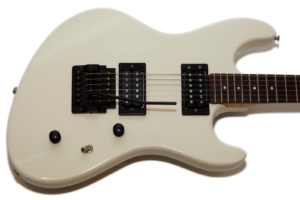
Since I have always favored Jacksons for my super Strat needs, I had never even considered one of these mid-late ’80s Guilds. Let’s see how it faired after I tore it apart and gave it the review treatment.
Introduction
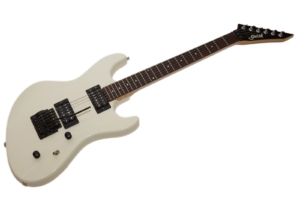
As much as I like to research this stuff, after I managed to score scans of the catalogs and price lists from the mid 1980s I’m still not sure what’s what. How do I know this is a 1986 S-281? Because I emailed Hans Moust (author of the Guild Guitar Book) who kindly told me so. You see, Guild did away with the model number on the truss rod for these guitars and there are no labels inside the control cavity so the only way to really know for sure is to have an original receipt (probably) or to ask Hans. As for why it’s an S-281 and not an S-280, we’ll just have to wait for his next book to find out, and after going through the meager documents I have access to, I’d say that book will be worth every penny.
2021 Edit: An S280 has a “foot” headstock while an S281 has the pointy headstock seen on my guitar.
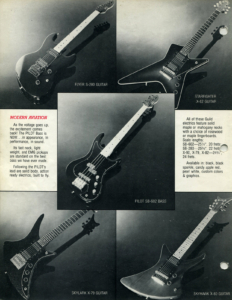
My best description of the S-281 is that it’s kind of a goofy-looking Strat-like guitar with offset horns, a bolt-on neck, rosewood fretboard, a poplar body and dual humbuckers. Oh yeah – with a Kahler. The Kahler makes it a super Strat I suppose, but do they all have Kahlers? Apparently not. Here’s where I try my best to research what the actual answer might be. Hint: I have limited resources and patience and would rather spend the time abusing this cool white guitar from the ’80s.
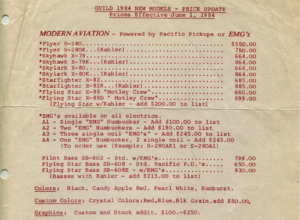
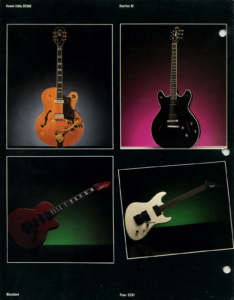
As previously mentioned, the 1984 Price guide shows an S-280 and an S-280K where the S-280 was $550 and the S-280K was $750. You could also order Custom or Stock graphics for another $100-$250. Let’s talk about those graphics, shall we?
The ’80s was the time of custom graphics, and Guild was not about to be left behind by that craze, nor were they to be left out of the “could you make it an even hotter pink” thing that also seemed to be happening.
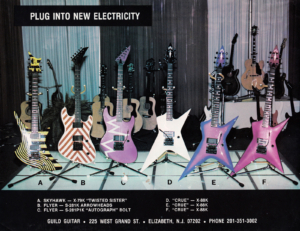
I can still smell the Aquanet.
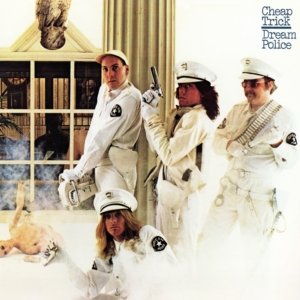
Even though it’s not an exciting hot pink guitar with a white heartbeat on it, I can easily imagine a group of long-haired ’80s guys wearing all white, probably with matching white captain’s hats and black highlights. That would be a perfect look for an all-white (eggshell?) guitar such as this. Nah, that would just be silly. I mean, that album was released in 1979 years before the release of the Guild S-280 let alone the S-281. Also only two of them had long hair. Oh, and from what I’ve been able to find none of them played Guilds.
This is a fun guitar. I kind of wish I had it during the ’80s, but I have it now and though pink spandex may have gone out of style (at least for men), shredding on a cool guitar like the Guild S-281 never will.
Finish
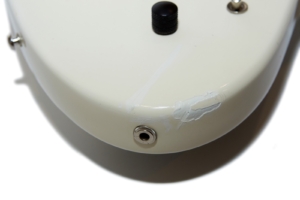
A word about the color of this guitar is in order. It’s white. Well, ivory. Actually it’s sort of an eggshell and it’s not quite cream. Screw it; it’s white…ish.
Colors available as listed in the 1984 price guide include Black, Candy Apple Red, Pearl White, and Sunburst, though custom “crystal” colors were also listed for a $50 upcharge, so I guess this guitar is pearl white. The reason I go on about what color it actually is has to do with the fact that digital cameras have something called white balance and different lights, all of which look white to our human brains, are perceived differently by the camera.
Since I recently got a new pure white backdrop for my photos I naturally also scored my first white guitar. Photographing white objects on a white background can be complicated but the issue is easily solved with the right lighting setup – a lighting setup that I don’t have. That’s why in some of the photos the guitar looks very white while in others it looks sort of off-white: because I don’t have the right equipment and I’m too lazy/stupid/unwilling to adjust all of the photos to have the matching white balance. It’s a white guitar; moving on.
Well, off-white…
Fretboard and Neck
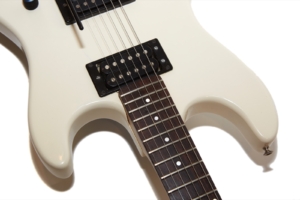
The neck is a natural maple and the fretboard is unbound rosewood. The fret markers are likely pearloid dots. The neck measures 1 5/8″ at the nut and the neck has a nice feel to it. It’s not rediculously thin like many Ibanez RGs I’ve played, but rather has more of a Strat shape to it. I was surprised at how much I liked the neck given my dislike for 1 5/8″ guitars and I think it might have something to do with the neck being unbound. As a matter of fact, all of the 1 5/8″ necks I like from Guild are unbound. Coincidence? Further study is needed.
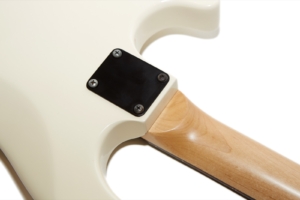
I had to measure the frets about five times because I had trouble believing a Guild had anything but low wide frets, but now that I was looking for it, I realized that I could easily squeeze chords out of tune on this guitar which is not something I can do on my other Guild electrics, and just to placate the doubters out there who think “that’s because of the Kahler”, if there wasn’t enough room between the top of the frets and the fretboard, it wouldn’t be possible to squeeze the strings out of tune regardless of the bridge installed. Luckily I spent years playing Jacksons so my death-grip chord days are behind me otherwise the frets probably would have driven me crazy.
This is also the first Guild I’ve ever owned that has a bolt-on neck. I would have pulled it but was hesitant to do so given the existing cracks shown in the next section.
I’m not usually a fan of bolt-on necks, mostly because my only guitar for years was a Guild S300A-D with a set neck and because of my love of Jackson thru-necks, so the feeling of the big square neck joint is kind of jarring to me. My one and only bolt-on guitar before this one is an American Deluxe Fender Stratocaster that has the sharp corner smoothed down which makes it more tolerable. Surprisingly this guitar doesn’t bother me at all and I’m not sure why. It’s got to have something to do with the overall geometry of the instrument. Perhaps be big long body alters the center of gravity which means I don’t pick it up right at the heal like I do most other guitars. I do notice the heal when I play the highest of the 22 frets, but apparently it’s not a deal breaker for me anymore.
Build Quality
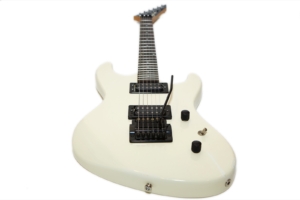
This guitar weighs 8 lbs 2 oz, the vast majority of which is in the poplar body. Although the shape of the guitar is perhaps best described as a Strat that was left in the sun too long, the cut of the body is really quite ergonomic. With the bottom contour making the guitar great to play in a sitting position and the beveling across the top where your right forearm rests, this is really an amazingly comfortable guitar.
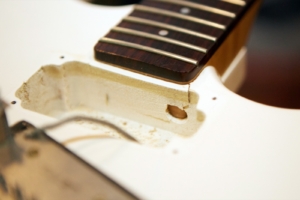
Although the big butt on this guitar would lead you to believe that it would be very tail heavy, the center of gravity is right below the neck pickup so it hangs well when standing and just feels great. Judging by feel along, this is an absolutely fabulous guitar. Plus I get the feeling that I could club an interloper with it a-la Keith Richards and I bet it would stay in tune. Hell, judging by some of the cracks and patches in this thing, that may have already happened.
Pickups
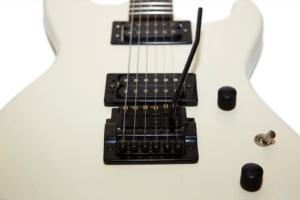
Of the two pickups in this guitar, only the neck is original, while the bridge is a Dimarzio DP-212 Eric Johnson Custom F-spaced pickup that was retrofitted at some time in the past. It sounds killer, and that’s all I’ll say about that since this is not an article about Eric Johnson custom pickups.
The pickups on this guitar are spaced farther apart than they are on any other dual humbucker guitar I have. My Jackson SL2H has them spaced 2.5″ measuring from slug to slug (slugs are the non-adjustable pole pieces on the pickups) while this S-281 Flyer measures 3.5″ from slug to slug. Both of the guitars in question are 25.5″ scale (OK, one is 25 5/8″) two-humbucker guitars but the Jackson has a 24-fret neck where the S280 has only 22 frets. Looking at my other Guilds, all of the dual-humbucker models are 24.75″ scale length and come with 24-fret necks so this guitar seemed very odd to me at first glance.
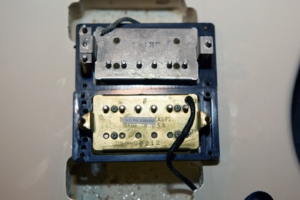
Both of the pickups give good initial impressions but I can’t say that I was blown away by either of them. I also wasn’t annoyed enough to replace them, so I suppose that puts them in a certain sweet spot. To be fair, I did like them with high gain which is really what this guitar is all about.
Electronics
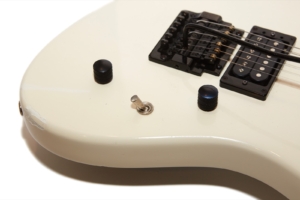
In this guitar, the two pickups connect to the pickup selector switch, the pickup connector switch connects to the Tone and Volume knobs, and the Volume knob connects to the output jack. The end. They actually did make a simpler one with only one pickup, volume and tone which is a pretty cool combination, especially in red.
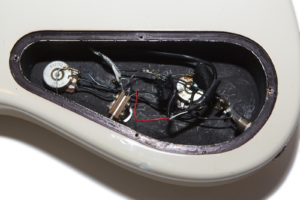
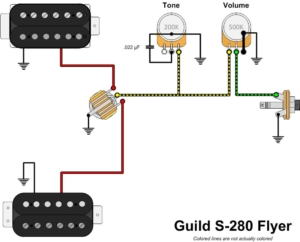
The wiring in the control cavity was less than clean when I got it, but I can’t blame that on Guild since one of the pickups was replaced. Whoever did that work was a fan of electrical tape because there was a fair bit of it in there insulating the signal bits from the grounding bits but it does its job.
Hardware
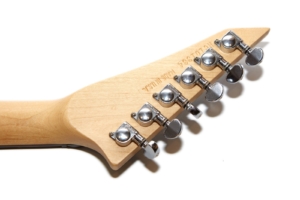
Knobs are very nice knurled metal affairs that match the Kahler bridge nicely. The knobs are very far apart and the pickup selector switch is similarly spaced away from the knobs making this guitar a delight to use since it’s not often you’ll grab the wrong control. The pickup selector switch is typical of Guild electrics from the ’70s and ’80s including the fantastic metal switch tip that’s so hard to replace.
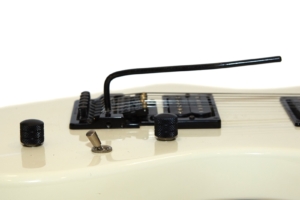
The bridge appears to be a Kahler 2300 Pro which is a very well made unit which sort of surprised me because I spent the ’80s espousing my hatred for Kahlers and looking at this one, I have to wonder why. It’s low-profile, rock solid, and does the job. The only complaint I have with it thus far is that my palm tends to rub against the fine tuning knobs which throws the low E string out of tune, sometimes by a lot.
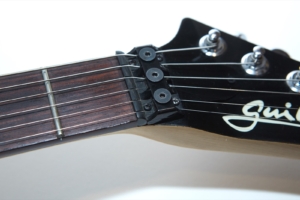
Sound
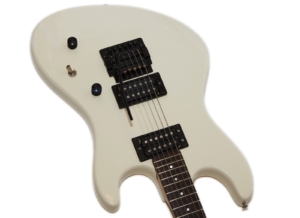
I like this guitar a lot with the super high-gain amp settings and having them on just begs for whammy bar abuse.
Tiny Tweed
D-Shape Chords
Open Chords #1
Open Chords #2
BackLine
D-Shape Chords
Thor’s Hammer
D-Shape Chords
12th Fret Riff
Warmup Riff
’80s Sounding Nonsense
I quite enjoyed the neck pickup tones on all settings, but especially with high gain when soloing on the high frets. I enjoyed the bridge pickup with power chords, drop-D stuff and especially some down-tuned chugga chugga metal riffs with the volume turned up loud.
I found that I didn’t necessarily enjoy this guitar for Van Halen stuff, and I’m not exactly sure why. I don’t thing the guitar interacted with the amp in a way that I felt the individual string articulation during chords. This is one of those times where I’m overanalyzing things, though, and I think is one of those “only the guitarist even notices” things. Still, I noticed.
I kind of also felt like the guitar didn’t have quite the sustain that I like, though with the compressor on and the gain turned up sustain can be forced from it with ease. Playing the guitar on the edge of feedback was easy and rewarding but sometimes on even a Plexi setting I felt like I had to coax work to get the guitar to sustain more. Remember, this is a guitar that’s apparently had a rough life, so there’s no telling if it’s this guitar, the pickups, or maybe just this Kahler that’s robbing the guitar of sustain.
In short, I felt like I was relying almost 100% on the amp for tone. That’s not the end of the world especially in the heavier metal genres, but it was notable to me having played many vintage Guilds with sweet clean tones all around.
Playability
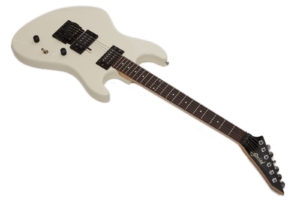
The Kahler has its fans and detractors to be sure, and I was initially quite impressed with the build quality of the floating bridge, but I did have issues rubbing the fine tuners when palm muting or resting on the bridge and probably as a result, I felt like I had to tune the guitar more than I do my Floyd Rose quipped guitars. The fine tuners are also easier to turn and have a wider range of adjustment than the Floyd Rose. I was actually able to tune the low E down a half step which I can’t easily do on a Floyd, though of course I then had to retune the rest of the strings, but I found that to be a cool “feature”.
Another thing that seemed to happen a fair bit was that I would hook the bar on the high E-string during serious dives. This is likely a habit I’ve developed with the Floyd Rose, and I’m sure I could train myself out of it, but it happened quite a few times so I thought I’d mention it.
Note that my last two issues may be 100% Kahler related and not necessarily the fault of the guitar, but since many of these S280s and S281s came with Kahlers, I felt they were worth a mention.
Conclusion
It’s probably not fair to make a judgement on a guitar when it’s bashed and bruised, has only one original pickup and none of the original tuners, but this is a damn fine guitar. In fact, I was so impressed by this Guild S-281 from 1986 that I started to seek out other aviation Guilds from the ’80s.
This guitar is very simple, very comfortable, and plays great. Yeah, it’s got that pointy-stock ’80s thing going on, but no matter its looks, this is a great guitar. Believe it or not I had this and my 1988 Guild Liberator Elite at the same time and I was happily going back between them non-stop for weeks, and in some ways that you’ll read about when I review the Liberator Elite, this guitar was better than that top of the line shredder!
The best part about this guitar is the price. This is an American made super-Strat that I scored for about $350, and many of the Guilds from the same era sell for similar prices. Sure, it may cost more in mint condition, but even then I see them sell for $500. This is a LOT of guitar for the money.
Honestly, I was surprised how much I liked playing this guitar. These guitars seem to go unnoticed by a lot of people which is a shame because they really can rock. Sure, you might end up changing the pickups, but that’s true of almost any guitar (for me, anyway). Maybe the pointy headstock is not your thing, and maybe the idea of a Kahler make you roll your eyes, but if you want or need a guitar to get your ’80s on, this is a great way that with an American-made guitar for not a lot of cash. Plus, don’t forget that stop-tail models are out there.
Be on the lookout for more reviews of ’80s Guild shredders at gadsguilds.com because this guitar is the gateway drug to them all and I am so hooked.
Donate: PayPal Crypto:
ETH: 0x0AC57f8e0A49dc06Ed4f7926d169342ec4FCd461
Doge: DFWpLqMr6QF67t4wRzvTtNd8UDwjGTQBGs

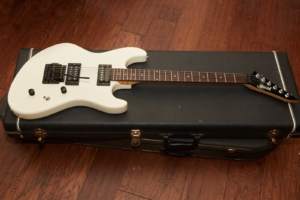


https://www.adkguitar.com/pages/dating-a-guild-guitar . Yours is a ’86 by this chart. I have a ’84 Maple hardtail, I bought it for $135 at a pawn shop way back around 1990 +/-. I love this guitar, It’s been a keeper all these years.
That serial number chart is a direct copy of this one from Guild: https://support.guildguitars.com/downloads/datingyourguild.pdf
The published serial number charts are known to be wrong in many places so I’ve learned not to trust them. If you want an accurate date for your guitar, send the serial number to Hans Moust at https://www.guitarchives.nl/guitarsgalore/. Hans has the actual Guild ledgers from Westerly and can give you an accurate date.
I agree that these guitars are woefully undervalued.
I have a candy apple red all original, but the head stock does not look the same. It more resembles a telecaster head and the guild logo is a traditional block style. I am the original owner and bought this guitar back in the mid 80’s. I also have the Guild list but could not find the serial number, it’s HC100092, this is my go to guitar along with my Washburn a20V, which is also all original..
IF it has the rounded headstock then it’s an S280 Flyer. Otherwise essentially the same guitar. Glad you love it! If you want to know the exact date email Hans Moust at his website: http://www.guitarchives.nl/guitarsgalore/
I have been searching for my first S280 which I purchased new from Dadario’s Music in CT…1984 model white with blue zebra stripes. I had sold it in 1993 or 94 in VA Beach. I don’t have the bill of sale or serial number anymore, but would love to be able to bring it home. Any assistance would be phenomenal. Thank you. Peter Hristov.
That’s a pretty rare finish – hopefully someone sees and responds!
I just purchased a (listed) S-281 Flyer with pick guard and SSS layout. I’d love to learn anything about this guitar you might happen to know. Thanks!
I’d love to see it. Could you send me pics? gad@gad.net.